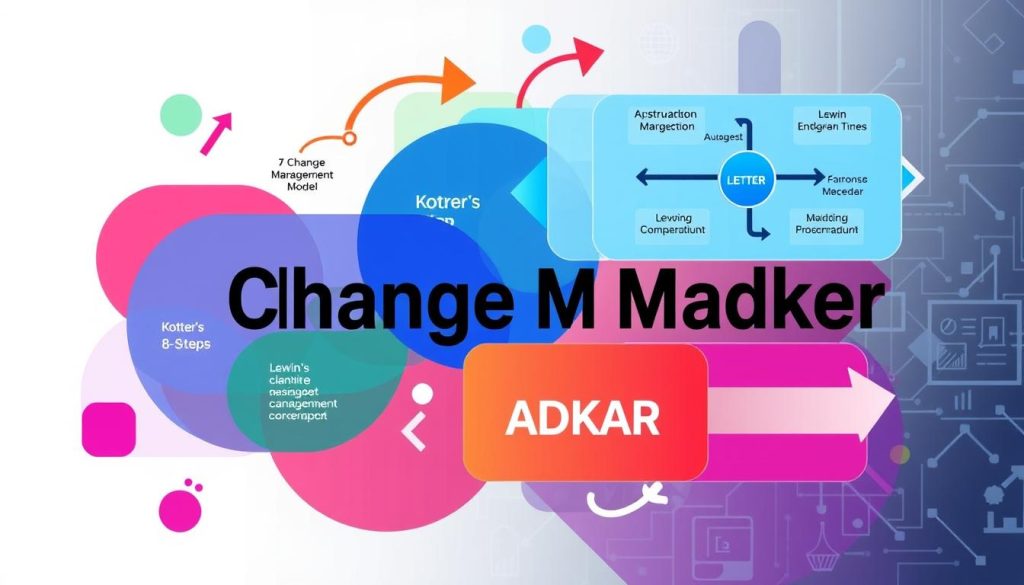In today’s fast-paced business world, change is a must for survival and growth. Managing change well can make all the difference. As a business leader, I’ve seen how strategic change management helps organizations through tough times.
Starting a change management journey can seem scary, but with the right tools, you can do it. This guide will cover the basics of strategic change management. You’ll learn about its key parts and how to use best practices to get results.
Good change management is key to achieving project goals. Studies show that using change management strategies can increase success by up to seven times. By following a structured approach, like the Prosci 3-Phase Process, organizations can get ready for change, manage it, and keep the results.
The Prosci ADKAR Model focuses on five important outcomes for change: Awareness, Desire, Knowledge, Ability, and Reinforcement. Change leaders can overcome resistance and build a culture of adaptability by focusing on these areas. Prosci research shows that not understanding why change is needed is the main reason for resistance, making clear communication vital.
Starting your change management journey, keep in mind that about 50 percent of change efforts fail. But, by improving your skills, doing thorough analysis, and using the right tools, you can help your organization succeed through change.
Table of Contents
Key Takeaways
- Strategic change management is crucial for navigating organizational transformations successfully.
- Structured approaches, such as the Prosci 3-Phase Process and ADKAR Model, provide a framework for managing change.
- Effective communication is essential for building awareness and mitigating resistance to change.
- Developing change management skills through training and education can enhance leadership capabilities.
- Conducting analysis and review after a change initiative helps understand its success or failure and informs future efforts.
What is Strategic Change Management?
Strategic change management helps people, teams, and companies move from where they are to where they want to be. It involves planning, putting changes into action, watching how they go, and making sure they stick. By using proven change management principles, companies can handle big changes better.
Definition and Importance
For companies to stay ahead, they need strategic change management. It helps them keep up with new technologies, market changes, and what customers want. A good change management plan can bring many benefits, like better performance, happier employees, and more satisfied customers.
- Improved organizational performance and efficiency
- Enhanced employee engagement and morale
- Increased customer satisfaction and loyalty
- Successful implementation of new technologies and processes
Studies show that about 30% to 40% of change efforts succeed. But, big changes can boost company performance by up to 25%. This shows the value of making big changes in strategy.
Key Components
The Prosci Methodology is a detailed plan for change. It has three main parts:
- Prosci ADKAR Model: This model helps employees get on board with changes. It covers Awareness, Desire, Knowledge, Ability, and Reinforcement.
- Prosci 3-Phase Process: This process helps organizations go through Preparing for Change, Managing Change, and Reinforcing Change.
- Prosci Change Triangle (PCT) Model: The PCT Model stresses the need to handle the people side of change. It also focuses on project management and leadership.
Differences from Traditional Change Management
Strategic change management is different from traditional change management in several ways:
| Strategic Change Management | Traditional Change Management |
|---|---|
| Proactive and anticipatory | Reactive and responsive |
| Focuses on long-term goals and vision | Addresses immediate issues and challenges |
| Involves all levels of the organization | Often limited to specific departments or teams |
| Requires strong leadership commitment | May lack senior leadership involvement |
Successful change management can control costs, manage productivity, support innovation, and improve morale.
By using strategic change management, companies can handle big changes better. This helps them succeed in a changing business world.
The Need for Strategic Change Management
In today’s fast-changing business world, staying ahead is key. Strategic change management helps companies adapt to new market trends, tech, and customer needs. This way, they keep their edge and thrive in the long run.
Change is a constant due to many factors like new rules, product updates, growth, more competition, and changes in the workforce. A smart change management plan lets companies tackle these changes head-on. It opens doors to growth and staying relevant in the market.
Market Dynamics
Keeping an eye on market changes is crucial. Companies need to watch trends, predict disruptions, and act fast. With organizational agility, they can quickly adjust to new chances and avoid risks.
Technology and Innovation
Technological advancements are changing things fast. To stay in the game, businesses must go digital. Strategic change management helps them adopt new tech, make processes smoother, and encourage innovation.
« Change is the law of life. And those who look only to the past or present are certain to miss the future. » – John F. Kennedy
Organizational Growth
As companies grow, they face new hurdles. Strategic change management is key to aligning resources, processes, and people for growth. It keeps them agile, ready to meet market changes, and open to new chances.
| Change Driver | Strategic Response |
|---|---|
| Market Dynamics | Develop organizational agility |
| Technology and Innovation | Embrace digital transformation |
| Organizational Growth | Align resources, processes, and people |
By adopting strategic change management, companies can handle today’s business world’s complexities. They keep their competitive edge and set themselves up for lasting success.
The Strategic Change Management Process
Change in today’s fast-paced business world needs a clear plan. This starts with a detailed change impact assessment. It checks if the organization is ready for change and finds any obstacles.
A thorough stakeholder analysis is also done. It finds out who is important and their roles in the change.
After assessing and analyzing, a detailed change management plan is made. It outlines the steps, timelines, and resources needed for success. This plan acts as a roadmap, covering all parts of the change.
Implementation Strategies
Good strategies are key for change success. These include:
- Clear communication to keep employees informed and involved
- Training programs to give employees the skills they need
- Support and resources to help employees adjust to the changes
McKinsey research shows that change programs with strong governance and clear roles are 6.4x more likely to succeed.
Evaluation and Feedback
It’s important to regularly check if the change is going well. Key performance indicators (KPIs) should be set to track progress and find areas for betterment. Feedback, like surveys and focus groups, gives insights into how employees feel and helps solve problems quickly.
| Change Management Best Practices | Benefits |
|---|---|
| Proactive change leaders | Inspire confidence and clear decision-making |
| Clear and specific change communication | Keeps employees informed and engaged |
| Defining KPIs and metrics | Measures progress and identifies areas for improvement |
| Prioritizing guiding people through the transition | Helps employees adapt to changes |
| Providing detailed and ongoing employee training | Equips employees with necessary skills |
By using a structured implementation roadmap and strong monitoring and evaluation practices, organizations can handle change well. They can come out stronger and more resilient.
Leadership’s Role in Change Management
Leadership is key to the success of any change in an organization. When top management supports a change, it shows its value. The Prosci Best Practices in Change Management report says strong leadership is crucial for success.
But, many leaders struggle to guide employees through change. Lack of support from leaders is a big problem. Prosci research shows that leaders who actively participate are essential for change success.
Importance of Leadership Buy-In
Leadership support is vital for change. When leaders are on board, they can provide resources and direction. Starting change early in a project leads to better results, Prosci research finds.
Developing Change Champions
Change champions at all levels can boost support for change. They help spread the word and address concerns. Empowering these champions helps drive change forward.
| Change Management Approach | Success Rate |
|---|---|
| Change management started during initiation | Higher success rate in meeting or exceeding objectives |
| Change management started during closure stages | Lower success rate in meeting or exceeding objectives |
Communication Strategies
Good communication is crucial during change. Employees look to their supervisors for personal updates and top leaders for business news. Leaders should keep everyone informed and engaged.
Organizations with strong communication strategies are 3.5 times more likely to outperform their peers.
Training during change can boost employee productivity by 29%. By focusing on employee engagement, leaders can build a culture ready for change. This leads to success for the organization.
Building a Change-Ready Culture
In today’s fast-paced world, companies that adapt quickly do best. They need a change-ready culture to handle new challenges and opportunities. By focusing on employee resilience, continuous learning, and skill development, they build a team that welcomes change and drives innovation.
Encouraging Adaptability
Adaptability is key in a change-ready culture. Leaders should support and take part in change efforts. This shows they’re serious about change. A culture of open communication lets employees share ideas and concerns, making them part of the change.
Studies show that many plans fail because of lack of employee support and internal conflicts. Yet, 87% of those in the Prosci Best Practices in Change Management study say knowing the culture is crucial.
Employee Engagement
Getting employees involved in change is vital. It lets them bring their unique ideas and help improve things. Seeing failure as a chance to learn helps build resilience and perseverance.
| Strategy | Description |
|---|---|
| Open Communication | Encourage employees to express ideas, concerns, and feedback |
| Middle Management Involvement | Engage middle managers as change agents and communicators |
| Gamification | Make the change process fun and engaging through gamification techniques |
| Addressing Resistance | Proactively identify and address sources of resistance to change |
Training and Development
Investing in continuous learning and skill development is key. Giving employees the tools and training they need helps them adapt. Using methods like the Prosci Methodology and certification programs can help with successful culture change.
Companies that embrace change are more likely to thrive, innovate, and stay ahead of the competition.
Recognizing milestones and achievements helps keep a positive vibe. Regular feedback from employees shows they’re valued and heard. This builds a sense of ownership and accountability.
Tools and Techniques for Change Management

Effective change management needs a clear plan and the right tools. Organizations can use models, software, and communication platforms. These help make the change process smoother and achieve goals.
Change Management Models
Change management models offer structured ways to plan and implement change. Two well-known models are Kotter’s 8-Step Change Model and Lewin’s Change Management Model.
| Model | Key Features |
|---|---|
| Kotter’s 8-Step Change Model |
|
| Lewin’s Change Management Model |
|
Software Solutions
Change management software and project management tools help streamline processes. They assign tasks and track progress. These platforms offer features like:
- Task assignment and tracking
- Collaboration tools
- Document management
- Reporting and analytics
- Risk assessment and mitigation
Using these tools, organizations can improve efficiency and success in change initiatives.
Communication Tools
Good communication is key for successful change management. Platforms like intranets, newsletters, and forums share information and feedback. They help:
- Keep employees informed about the change process
- Address concerns and gather feedback
- Celebrate milestones and successes
- Reinforce the importance of the change initiative
The greatest danger in times of turbulence is not the turbulence itself, but to act with yesterday’s logic.
– Peter Drucker
By combining change management models, software, and communication platforms, organizations can manage change well. This drives successful transformations.
Overcoming Resistance to Change
Change is a natural part of growth in any organization. Yet, it can be hard to implement because people often resist new ideas and ways of doing things. This resistance comes from fear, job security worries, or not understanding the change’s benefits.
McKinsey & Company found that 70% of change efforts fail. This is mainly because of employee resistance and lack of support from management. Good change management can reduce this resistance. It helps avoid delays, lower productivity, and higher costs.
Identifying Sources of Resistance
To beat resistance to change, we must find out why people resist. Common reasons include:
- Lack of trust in leadership
- Poor communication
- Emotional responses like fear and uncertainty
- Fear of failure
- Surprises in the form of unexpected changes
- Constant organizational changes without proper spacing
Strategies to Address Concerns
After finding out why people resist, leaders can start to address their concerns. Good communication strategies are key. They help connect employees and management during changes. Leaders should talk early and often, sharing clear reasons and expected results.
Getting employees involved in the change can also help. By listening to their thoughts and feelings, leaders show they care. This builds trust and makes employees feel more invested in the change.
The Role of Emotional Intelligence
Emotional intelligence is crucial in overcoming change resistance. Leaders need to show empathy and listen actively. This helps them understand and address employee worries.
« Active and visible executive sponsorship » is the top contributor to the success of change initiatives. – Prosci
Leaders with high emotional intelligence can handle change better. They create a supportive space for open talk, teamwork, and flexibility.
Communication in Change Management
Effective communication is key to successful change management. With 70% of change efforts failing due to poor communication, it’s vital to have a solid plan. This plan helps stakeholders understand the changes, why they’re happening, and how they’ll be affected.
To make a strong change communication plan, align it with business goals. Define what behaviors you want from employees and tailor messages for different groups. This way, you can support your change management strategy effectively.
Crafting Effective Messages
When making your change communication plan, keep these tips in mind:
- Tailor messages to specific audience types
- Focus on the benefits and positive outcomes of the change
- Be transparent about the reasons behind the change
- Address potential concerns and fears
- Encourage employee feedback and participation
Channels of Communication
Using a variety of communication channels helps reach all stakeholders. Here are some channels to consider:
| Channel | Best For |
|---|---|
| 1:1 Meetings | Communicating sensitive changes or when an employee’s role is significantly impacted |
| Formal announcements about significant company policy, leadership, or strategic direction changes | |
| Internal Communication Tools (Slack, MS Teams) | Minor, quick updates or reminders and fostering discussion in real-time |
| Town Hall Meetings | Presenting the big picture, addressing concerns, and engaging in Q&A sessions |
Timing and Frequency
The timing and frequency of your plan should be strategic. Regular updates and feedback opportunities are key. Here are some best practices:
- Communicate early and often
- Provide regular progress updates
- Encourage ongoing stakeholder engagement
- Adjust the communication timeline as needed based on feedback and progress
Employees are the driving force behind organizational shift, emphasizing the importance of their understanding of change for successful adoption.
By creating a detailed change communication plan, you can manage change effectively. This plan should include clear messages, various communication channels, and strategic timing. This way, you can drive positive outcomes in your organization.
Measuring Success in Change Initiatives
It’s key to check if change efforts are working well. This ensures they bring the expected benefits and help the company grow. By using clear metrics and watching progress, companies can make smart choices. They can also tweak their plans as needed.
A good way to measure success includes looking at key performance indicators (KPIs), getting feedback from employees, and always trying to get better.
Key Performance Indicators (KPIs)
KPIs are measurable signs of progress and success in change efforts. A study by MI-GSO | PCUBED found that projects with a good change success metrics approach see a 6.5 times higher ROI. Important KPIs include:
- Time-to-adoption: How fast employees start using new processes or tech
- Process improvement metrics: How the change affects work efficiency
- Incident reduction: The drop in errors or issues after the change
- Return on Investment (ROI): Comparing financial data before and after the change
Surveys and Feedback Mechanisms
Feedback from employees is crucial to know if change efforts are working. Zendesk says treating employees as internal customers is key in change management. Surveys and feedback tools help organizations:
- Check how engaged employees are with the Net Promoter Score (NPS) and pulse surveys
- See if stakeholders are happy with company-wide surveys and polls
- Find out if training is effective by looking at attendance and knowledge retention
- See if new skills and behaviors are being used at work after training
Continuous Improvement
Success in change efforts is not just a one-time thing. It’s an ongoing process of checking and improving. By regularly looking at KPIs and feedback, companies can spot areas to get better. This helps them make smart choices to improve their change management.
This way, change efforts stay on track with the company’s goals and what employees need. It leads to lasting success.
Knowing the « Why » behind any change is key to its success. It gives employees a reason to care and a goal to aim for.
In summary, measuring success in change efforts needs a mix of numbers, feedback, and a focus on getting better. By using these insights, companies can handle the challenges of change management. This drives lasting growth in a changing business world.
Case Studies in Strategic Change Management

Looking at real-world examples of change management can teach us a lot. We can see what works and what doesn’t. This helps organizations learn from others and improve their own change efforts.
Successful Examples
A global electronics company with 18,000 employees and $28 billion in revenue is a great example. They used Lean initiatives to improve processes and meet their goals. A hospital system with 24,000 employees also succeeded by implementing a new ERP system and getting ready for healthcare reform.
Coca-Cola introduced healthier options like Coca-Cola Zero Sugar, showing they could adapt to consumer needs. Adobe’s switch to cloud-based services in 2011 is another success story. It shows the value of digital transformation.
Lessons Learned from Failures
Not every change effort works out. Kodak’s failure to adapt to digital technology is a lesson. Their revenue dropped from £12,52,16 billion in 1999 to £4,85,11,90 billion in 2011. In contrast, Fuji diversified and thrived, showing the need to embrace change.
A transportation department with 3,000 employees and $1.3 billion in revenue faced challenges. They didn’t manage to adapt, showing the importance of proactive change management.
Industry-Specific Insights
Different industries face unique challenges in change management. In the pharmaceutical industry, a global company with 5,000 employees and $6 billion in revenue overcame resistance after implementing SAP. This shows the value of addressing employee concerns and engaging stakeholders.
| Industry | Company | Revenue | Employees | Change Initiative |
|---|---|---|---|---|
| Manufacturing | Home fixtures company | $600 million | 3,000 | Operational efficiency changes |
| Technology | Web services software company | $3.3 billion | 10,000 | Cultural transformation and workspace changes |
| Security | High-tech security company | $10 billion | 57,000 | Major restructuring through a change network |
Studying these cases gives us insights into best practices and pitfalls in different industries. Using methods like Prosci’s ADKAR® Model can help ensure success in change initiatives.
Future Trends in Change Management
Organizations are facing new challenges in the modern business world. Change management strategies are evolving to meet these demands. In 2024, several trends are shaping the future of change management. These include technological advancements, changes in the workforce, and the need for agility.
Digital Transformation
Digital transformation is key in 2024. Organizations are focusing on using new technologies. This helps them become more efficient, innovative, and improve communication.
Nearly 70% of companies are using artificial intelligence and automation. They use these tools to make the change process smoother. They can also predict resistance and adjust strategies quickly.
Agile Methodologies
Agile change management is becoming more popular in 2024. It emphasizes flexibility, adaptability, and teamwork. By adopting agile principles, organizations can quickly respond to changes and work better together.
Agile methodologies are being used in change management. This allows for continuous progress and reduces risks.
| Trend | Impact on Change Management |
|---|---|
| Employee-centric focus | Higher engagement levels and better success rates |
| Leadership involvement | 70% of senior leaders overseeing change programs directly |
| Data-driven decision-making | Leveraging big data for effective strategies and understanding employee perspectives |
Remote Work Challenges
Remote work is now a permanent part of the business world. Change management strategies in 2024 must support remote workers. Organizations are focusing on creating supportive environments for employees’ mental, emotional, and physical health.
Effective communication is key for successful change in virtual teams. Technology helps with clear and timely communication.
The future of change management lies in enhancing employee experience, adopting technology, and fulfilling social responsibilities.
By embracing these trends, organizations can better navigate the future of work. They focus on employee well-being, use data insights, and create a culture of learning and adaptability. This helps them successfully implement changes and thrive in a world of remote work and digital disruption.
Best Practices in Strategic Change Management
Effective strategic change management needs proven best practices. These practices help organizations deal with change smoothly. They ensure long-term success. By following these guidelines, companies can reach their goals and stay competitive.
Clear Vision and Objectives
Having a clear vision and SMART goals is key. Research shows that change initiatives with good sponsors succeed 79% of the time. This is a big jump from those without sponsors.
By setting clear, measurable goals, organizations guide everyone involved. This direction helps in achieving the desired outcomes.
Stakeholder Involvement
It’s important to involve stakeholders in the change process. Early and frequent engagement helps gain support. Having « change champions » is also helpful in uniting the organization.
Listening to employees at all levels is crucial. It helps spot silent resistors and builds a collaborative atmosphere. This makes the buy-in process smoother.
| Best Practice | Impact |
|---|---|
| Effective Sponsorship | 79% likelihood of meeting objectives |
| Change Management Methodology | 59% effectiveness level |
| Dedicated Change Management Resources | Significantly higher change management effectiveness |
| Integrating Project Management and Change Management | Increased likelihood of meeting or exceeding project objectives |
Sustaining Momentum
Keeping momentum after the initial phase is vital. Ongoing communication and support are needed. Organizations that focus on reinforcement are more likely to succeed.
Effective change management tackles resistance and provides training. It ensures a smooth transition and desired outcomes. This is done by communicating clearly and monitoring progress.
Nearly three-quarters of all respondents integrate project management work and change management work to some degree.
Using generative AI for personalized communications can improve transparency and engagement. It helps address concerns quickly. Successful change management balances culture and strategy, focusing on a productive workforce.
Conclusion: The Path to Strategic Change Management Success
Strategic change management is key for companies today. It helps them deal with the business world’s challenges. The Prosci Methodology, with its ADKAR® Model and 3-Phase Process, offers a clear way to manage change.
Key Takeaways
Good change management starts with finding the reasons behind resistance. It also means talking to stakeholders and using strategies like Q&A sessions. A solid change plan aims to boost adoption and cut down on resistance.
It’s important to consider the scale of the change, who it affects, and the timeline. This helps tailor strategies for change in your organization.
Next Steps for Implementation
To start a strategic change management plan, you need to plan well and communicate clearly. Create a roadmap with goals, timelines, and roles. This helps manage the change smoothly.
Keep an eye on how the change is going and make changes if needed. Evaluating the change after it’s done is also crucial for success.
Resources for Further Learning
Learning never stops in strategic change leadership. There are many resources out there, like books and online courses. By keeping up with new trends, leaders can improve their skills.
Seeing change as a chance for growth helps organizations succeed. They can become stronger and more adaptable in uncertain times.
FAQ
What is the role of leadership in strategic change management?
Leadership is key to any change’s success. Getting top executives on board shows the change’s importance. It also helps align resources.
Creating change champions at all levels boosts support. Leaders must communicate well. They should keep everyone informed and engaged.
How can organizations build a change-ready culture?
A culture ready for change values being adaptable and always improving. Getting employees involved in the change helps them feel in control. Training and support are crucial for adapting to new things.
Continuous learning and skill development make a workforce resilient. This helps them handle changes well.
What strategies can be used to overcome resistance to change?
Change resistance comes from fear and job security worries. Finding the reasons behind it is the first step. Open communication and involving employees help.
Support systems and emotional intelligence are also key. Leaders need to listen and understand employee concerns.
How can the success of change initiatives be measured?
Measuring change success is vital. Set up KPIs early and check them often. Surveys and feedback help understand how employees feel.
Improving continuously means making changes based on feedback. This keeps the change on track and effective.
What are some best practices for effective strategic change management?
Good change management starts with a clear vision and specific goals. Involving stakeholders helps build support. Keeping momentum going is key for lasting success.
Communication and support are essential. They help reinforce the change over time.
How can organizations prepare for future trends in change management?
The future of change management is shaped by new trends. Digital transformation requires agility and adaptability. Agile methods are becoming more common in change management.
Remote work brings new challenges. Strategies for virtual collaboration and engagement are needed.
Source Links
- Change Management Process – https://www.prosci.com/blog/change-management-process
- 5 Steps in the Change Management Process | HBS Online – https://online.hbs.edu/blog/post/change-management-process
- The Importance of a Strategic Change Management Plan – https://www.acquisconsulting.com/our-thinking/the-importance-of-a-strategic-change-management-plan/
- Strategic Change: Meaning | Types | Examples – The Strategy Story – https://thestrategystory.com/blog/strategic-change-meaning-types-examples/
- What is Change Management Strategy? | Definition from TechTarget – https://www.techtarget.com/searchcio/definition/change-management-strategy
- Choosing Strategies for Change – https://hbr.org/2008/07/choosing-strategies-for-change
- 7 Reasons Why Change Management Strategies Fail and How to Avoid Them – Professional & Executive Development | Harvard DCE – https://professional.dce.harvard.edu/blog/7-reasons-why-change-management-strategies-fail-and-how-to-avoid-them/
- What is Change Management and Why is It Important? – https://www.smestrategy.net/blog/what-is-change-management-and-why-is-it-important
- The 10 Best Organizational Change Management Strategies – https://online.champlain.edu/blog/best-organizational-change-management-strategies
- What Is Change Management? Benefits, Principles (2024) – https://whatfix.com/change-management/
- Kellogg Executive Education – https://www.kellogg.northwestern.edu/executive-education/individual-programs/online-programs/ol-scm.aspx
- Mastering Change Leadership in Enterprise-Level Companies – https://www.prosci.com/blog/change-leadership
- Change Management for Leaders: Essential Strategies – https://voltagecontrol.com/articles/change-management-for-leaders-essential-strategies/
- How to Successfully Navigate Culture Change Management – https://www.prosci.com/blog/culture-change-management
- Building a Change-Ready Culture: Key Principles & Practices – https://www.linkedin.com/pulse/building-change-ready-culture-key-principles-kyle-hawkey-phd-rj4fc
- Building a Change-Ready Culture: Proactive Strategies for Success – https://www.linkedin.com/pulse/building-change-ready-culture-proactive-strategies-success-fadmoor-zk1oe
- The Ultimate 8 Change Management Tools for 2025 | Creately – https://creately.com/guides/change-management-tools-list/
- Top 10 change management models: A comparison guide – https://www.zendesk.com/blog/change-management-models/
- Overcoming Resistance to Change within Your Organization – https://www.betterup.com/blog/resistance-to-change
- Council Post: Three Tips For Managing Resistance To Change – https://www.forbes.com/councils/forbescoachescouncil/2020/06/15/three-tips-for-managing-resistance-to-change/
- Resistance to Change: 7 Causes & How to Overcome Them (2024) – https://whatfix.com/blog/causes-of-resistance-to-change/
- Change Management Communication: 5-Step Plan + Template – https://www.yourthoughtpartner.com/blog/change-management-communication
- How to Communicate Change: 7 Best Practices (2024) – https://whatfix.com/blog/best-practices-change-management-communication/
- Success of Change Management – https://www.holaspirit.com/blog/how-to-measure-the-success-of-change-management
- Measuring Essential Change Management Metrics for Success – https://www.suretysystems.com/insights/measuring-essential-change-management-metrics-for-success/
- 9 Successful Change Management Examples for Inspiration – https://www.prosci.com/blog/successful-change-management-examples-for-inspiration
- Change Management Case Study: Real-World Examples and Lessons – https://www.theknowledgeacademy.com/blog/change-management-case-study/
- 10 Key Change Management Trends to Watch in 2024 – https://whatfix.com/blog/change-management-trends/
- Unveiling the Future: 7 Key Change Management Trends to Watch in 2024 – https://www.linkedin.com/pulse/unveiling-future-7-key-change-management-trends-watch-mohapatra-pmt6f
- 10 Key Change Management Trends to Watch in 2024 – https://www.onindus.com/change-management-trends/
- Best Practices in Change Management – https://www.prosci.com/blog/change-management-best-practices
- Council Post: 19 Best Practices For Change Management Success – https://www.forbes.com/councils/forbeshumanresourcescouncil/2024/04/11/19-best-practices-for-change-management-success/
- Lost Without a Map? A Change Strategy to Guide Your Success – https://www.prosci.com/blog/change-management-strategy
- What Is Change Management? An Overview of the Process and Benefits – https://trainual.com/manual/what-is-change-management
- Change Management For Strategy Implementation – https://www.profit.co/blog/change-management/change-management-for-strategy-implementation/





